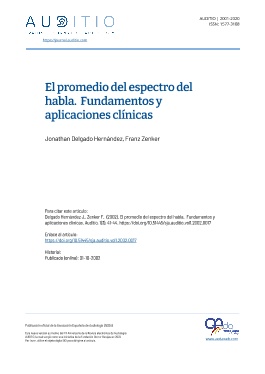Long-term Averaged Speech Spectrum. Fundamentals and Clinical Applications.
DOI:
https://doi.org/10.51445/sja.auditio.vol1.2002.0017Keywords:
averaged speech spectrum, LTASS, ICRA, hearing-aid fittingAbstract
One of the goals to in the clinical field of hearing-aid fitting is to achieve a comfortable and intelligible level of listening to speech. To achieve this objective, reference signals based on the average of the speech spectrum have been created with which to evaluate the gain of the hearing aids. Sex, age, location of the microphone or language are variables that influence the recording of this measurement. In this article we review the influence of these factors and present the possible audio-logical and hearing-prosthetic applications of this type of signals.
Downloads
Visibility and Altmetrics
Metrics
Global Statistics ℹ️
|
2798
Views
|
1234
Downloads
|
|
4032
Total
|
|
References
Cornelisse, LE, Gagné, JS, y Seewald, RC. (1991). Ear level recordings of the long-term average spectrum of speech. Ear Hear. 12, 47-54. https://doi.org/10.1097/00003446-199102000-00006
Byrne D, Dillon H, Tran K. (1994). An interna-tional comparison of long-term average speech spectra. J Acoust Soc Am; 96:2108-2120. https://doi.org/10.1121/1.410152
Cox, RM, y Moore, JN. (1988). Composite speech spectrum for hearing aid gain pre-scriptions. J. Speech Hear. Res.31, 102-107. https://doi.org/10.1044/jshr.3101.102
Byrne, D. (1977). The speech spectrum-Some aspects of its significance for hearing aid seleccion and evaluation. Br. J. Audiol. 11, 40-46. https://doi.org/10.3109/03005367709078831
Pearsons, KS, Bennett, RL, y Fidell, S (1997). Speech levels in varius noise Envi-ronment. EPA Rep. Nº. 600/1-77-025 Envi-ronmental Protection Agency, Washington DC.
Dunn, HK, y White, SD. (1940). Statiscal measurements on conversational speech. J. Acoust. Soc. Am.11, 278-289. https://doi.org/10.1121/1.1916034
Dunn, H. K., Farnsworth, D. W. (1939). Exploration of pressure field around the human head during speech. J. Acoust. Soc. Am. 10, 184-199. https://doi.org/10.1121/1.1915975
Benson, R. W., y Hirsh , I. J.(1953). Some variables in audio spectrometry. J. Acoust. Soc. Am. 25, 499-505. https://doi.org/10.1121/1.1907070
Niemoller, AF., McCornick, I., y Miller, J D.(1974). On the spectrum of spoken Eng-lish. J. Acoust. Soc. Am. 55,461. https://doi.org/10.1121/1.3437924
Byrne , D., y Dilon, H. (1986). The National Acoustic Laboratories'(NAL) new procedure for selecting the gain of frecuency response of hearing aid. Ear Hear. 7, 257-265. https://doi.org/10.1097/00003446-198608000-00007
Tarnoczy, T., y Fant, G. (1954). Some re-marks on the average speech spectrum. Q.P.S.R. Rep. Nº 4, pp. 13-14, Speech Transmission Laboratory, Stockholm.
Pavlovic, CV., Rossi, M., y Espesser, R. (1991). Perceived spectral energy distribu-tions for EUROMO speech and for some synthetic speech. Proccedings of the XII In-ternational Congress on Phonetic Sciences. 5/5, 418-421.
Zenker, F. (2002). La prescripción de la ganancia en la adaptación audioprotésica. Auditio: Revista electrónica de audiología. vol. 1(3), pp. 45-52. https://doi.org/10.51445/sja.auditio.vol1.2002.0018
Zenker F. y Barajas J. (1999). Adaptación de audífonos en función del promedio del espectro de la palabra hablada. Estudio de un caso único. En: Logopedia escolar y clínica. Últimos avances en Evaluación e Intervención. Editor: José Domingo Martín Es-pino, Madrid, Editorial CEPE, pp. 329-336.
Seewald, R., Cornelisse, L., Ramji, K., Siclair, S., Moodie. K., Jamieson, D. (1995). DSL TM for windows: A sofware sys-tem implementation of the desired sensation level (DSL) method for fitting linear gain ans wide-dynamic-range compression hearing in-struments. User's manual. University of Western Ontario.
Fry, GJ. (2002). El examen del audífono digital. [en linea]. Auditio: Revista electrónica de audiología. 1(2), pp. 25-29. DOILATER
Dreschler, WA., Verschuure, H., Ludvigs-en, C., Westermann, S. (2001). ICRA Nois-es: Artificial noise signals with speech-like spectral and temporal propieties for hearing instrument assessment. Audiology. 40: 148-157. https://doi.org/10.3109/00206090109073110
ANSI (1969). ANSI S3.5-1969, American Na-tional Standard Methods for Calculation of the Articulation Index (American National Stand-ards Institute, New York).
Zenker F. (2001). Medidas en oído real me-diante sonda microfónica. Definición y apli-caciones. [en linea]. Auditio: Revista electró-nica de audiología. vol. 1(1), pp. 10-15. https://doi.org/10.51445/sja.auditio.vol1.2001.008

Published
Versions
- 2021-09-15 (2)
- 2002-10-01 (1)
How to Cite
Issue
Section
License
Copyright (c) 2002 Auditio

This work is licensed under a Creative Commons Attribution 3.0 Unported License.
All articles will be published under the open Creative Commons Attribution (CC-BY) license. This license allows others to share and adapt the content, even for commercial purposes, as long as appropriate credit is given to the authors and the journal. By submitting their manuscript, authors retain copyright but grant the journal the right to make the first publication under this license.
More information about this license is available at: https://creativecommons.org/licenses/by/4.0/
Articles published between 2001 and 2020
The texts published in this journal in the section "AUDITIO 2001-2020" are subject - unless otherwise indicated - to a Creative Commons Attribution 3.0 Spain license. You can copy, distribute, communicate them publicly, make derivative works and commercial uses provided that you acknowledge the credits of the works (authorship, name of the journal, publishing institution) in the manner specified by the authors or by the journal. The full license can be consulted at http://creativecommons.org/licenses/by/3.0/es/deed.es.









